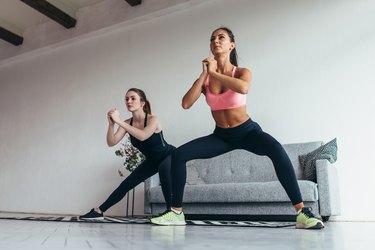
Your hip adductors are a cluster of muscles on your inner thighs. Together, they act to bring either leg in toward the midline of your body. For the best adductor workout, you need to use body weight or exercise equipment to duplicate that "toward the midline" motion.
Meet Your Hip Adductors
Video of the Day
The three muscles most typically classified as your hip adductors are the adductor brevis, adductor longus and adductor magnus, as explained at ExRx.net. But there a couple of other inner thigh muscles that help adduct your legs, or bring them together toward the midline of your body: the pectineus and gracilis.
Video of the Day
The lower fibers of your gluteus maximus — the biggest, meatiest muscle on the back of your hip — also pitch in to assist with hip adduction.
The muscles that adduct your hip also act, in various combinations, to flex, extend and externally rotate your hip. That means that even when they're not pulling your legs in toward the midline of your body, your hip adductors are still working in concert with other muscles of your pelvic girdle to stabilize your hips.
If you've ever dealt with a pulled or strained muscle in your groin, it was probably one of your hip adductors. As noted in a landmark data analysis published in the August 2009 issue of Journal of Strength and Conditioning Research, cohort studies indicate that stretching and strengthening your hip adductors is related to a lower risk of injury in certain sports, including soccer and ice hockey. But you don't have to be a competitive athlete to benefit from strengthening your inner thigh muscles.
Read more: Abduction and Adduction Exercises
Hip Adductor Exercises
For the first exercise in this hip adductor workout, you'll need either a low cable pulley or an elastic resistance band with an ankle cuff. If you use an elastic resistance band, you'll need to anchor it securely at about ankle height.
The second exercise can be done with no equipment — your body weight provides the resistance.
Regardless of the equipment you're using, one to three sets of eight to 12 repetitions is a good target to aim for, as recommended by the U.S. Department of Health and Human Services.
Move 1: Standing Hip Adduction
- Fasten the cuff of the cable or resistance band around your right ankle and stand with your right side facing toward the anchor point.
- Scoot away from the anchor point until you feel tension in the pulley or band. Put all your weight on your left (unanchored) foot. This is your starting position.
- Squeeze your core muscles to stabilize your hips as you draw your right foot in toward the midline of your body. For a slightly longer range of motion, allow your right (anchored) foot to cross just in front of your unanchored foot.
- Let your right leg return to the starting position with a smooth, controlled motion.
- Once you've completed a full set with your right leg, switch the cuff to your left leg. Turn so that your left side is facing toward the anchor point and complete a full set on that side.
Move 2: Side Lunges
Although this exercise is typically called the side lunge, it's really more like a one-sided squat.
- Stand with your feet hip-width apart. If you'd like a little help keeping your balance, stand just behind a counter, chair or any other sturdy object you can safely lean your weight on.
- Step your right leg smoothly out to the side, allowing that leg to bend at the knee as your hips sink down and back. Just as in a squat, your right knee should point in the same direction as your toes on that foot.
- At the same time, keep your left leg straight or nearly straight, foot still flat on the floor and supporting part of your weight. The end result looks as if you're performing a squat on your right leg, while your left leg stays anchored out to the side, as demonstrated at the American Council on Exercise.
- Let your comfort level dictate the depth of your side lunge. The more flexible you are, the lower you'll be able to comfortably go.
- Press off the floor with your right leg and return to the starting position.
Tip
Remember to work both legs evenly. You can alternate lunges from right to left, or do a full set on one leg before switching to the other.
Read more: 7 Dynamic Stretches to Improve Hip Mobility
- ExRx.net: "Adductors (Hip)"
- ExRx.net: "Pectineus"
- ExRx.net: "Gracilis"
- ExRx.net: "Gluteus Maximus"
- Journal of Strength and Conditioning Research: "Hip Adductors' Strength, Flexibility, and Injury Risk"
- American Council on Exercise: "Side Lunge"
- U.S. Department of Health and Human Services: "Physical Activity Guidelines for Americans"
Was this article helpful?
150 Characters Max
0/150
Thank you for sharing!
Thank you for your feedback!